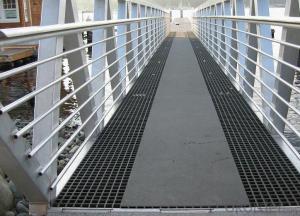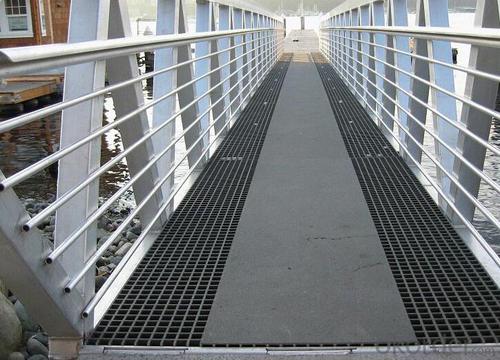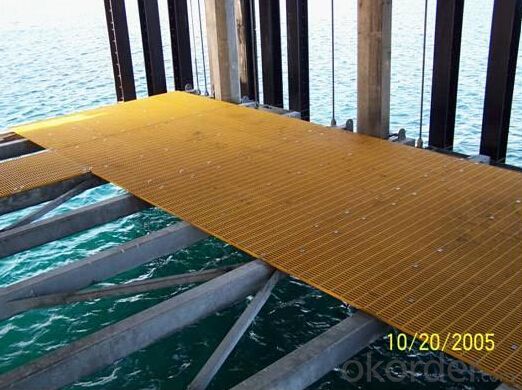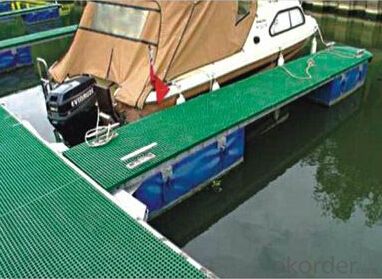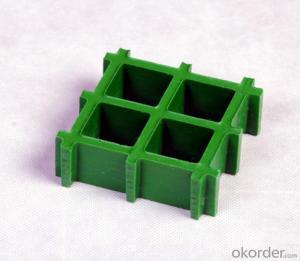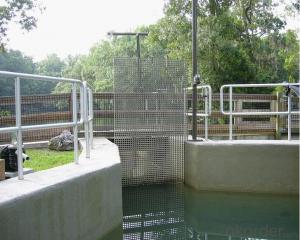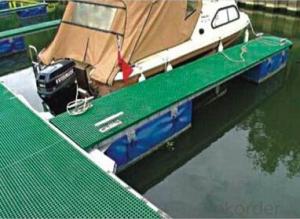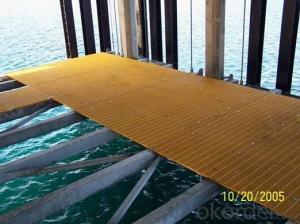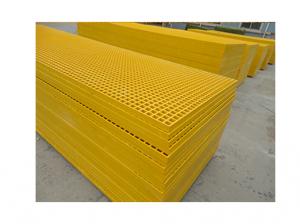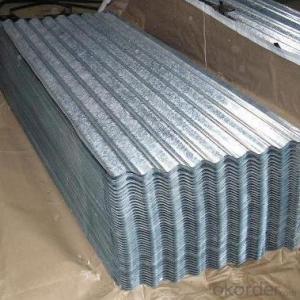FRP Pultrusion Profiles - Skid Resistance FRP Grating with Impact Resistance 2024
- Loading Port:
- Shanghai
- Payment Terms:
- TT OR LC
- Min Order Qty:
- 10 pc
- Supply Capability:
- 8000 pc/month
OKorder Service Pledge
OKorder Financial Service
You Might Also Like
Specification:
FRP molded grating made of vertical and horizontal continuous fiberglass fully soaked in unsaturated polyester resin giving perfect bi-directional mechanical properties. Combining unmatched corrosion resistance with strength, long life and safety, molded grating provide the ultimate in reliable performance, even in the most demanding corrosive conditions. Besides, it is easy to cut and install. CNBM offer the widest selection with panel sizes, colors and slip resistant surfaces, clients can avail FRP grating your specific requirements.
Product Features:
- Light but high loaded strength
- High anti-corrosion and anti-aging
- Easy installation and maintenance
- Low maintenance
- Non-conductive
- Lowest in life cycle cost
- Corrosion Resstance
- Anti-slippery
- Various sizes and color available
Colour Design:
To satisfy customer's design project, CNBM grating offers a wide selection of grating colors to choose from. The standard colors available for fiberglass grating as following:
- Blue
- Red
- Yellow
- Green
- Light Grey
- Dark Grey
Custom colors of fiberglass grating may be available upon request, you can contact us learn more.
Moded Grating Sizes List:
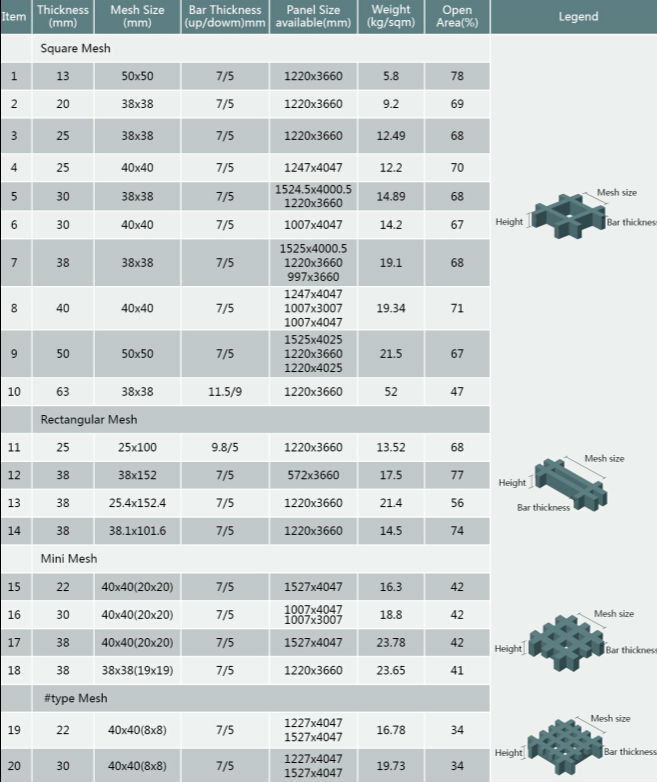
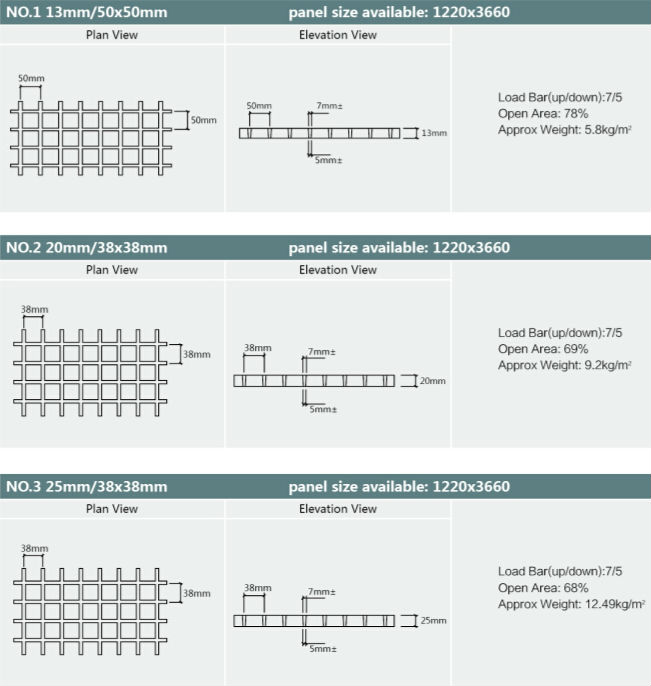
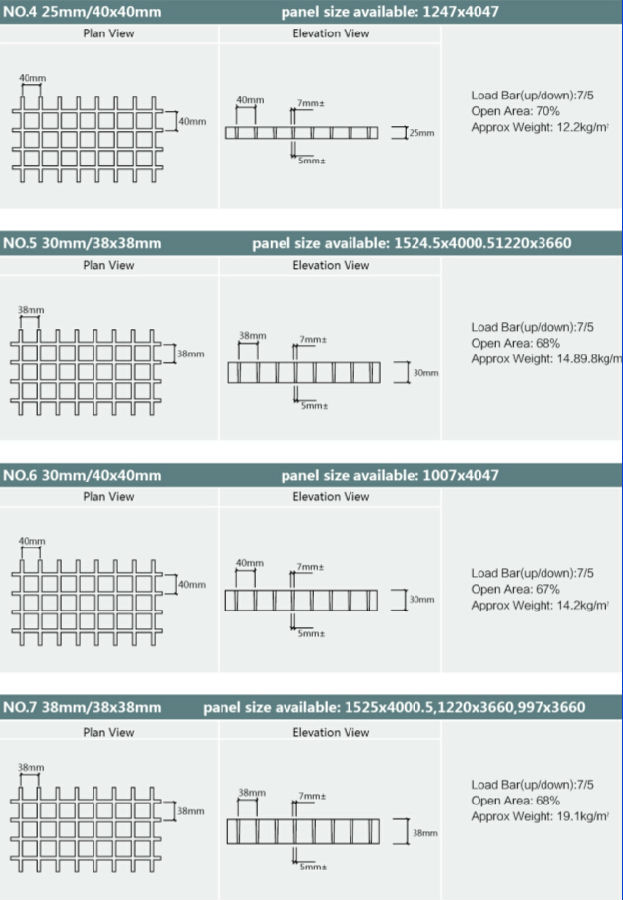
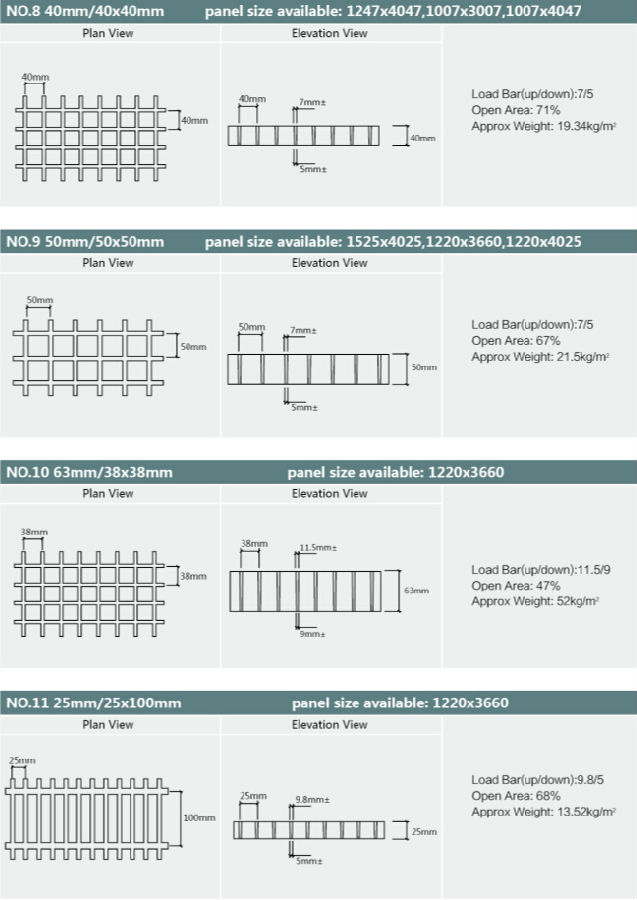
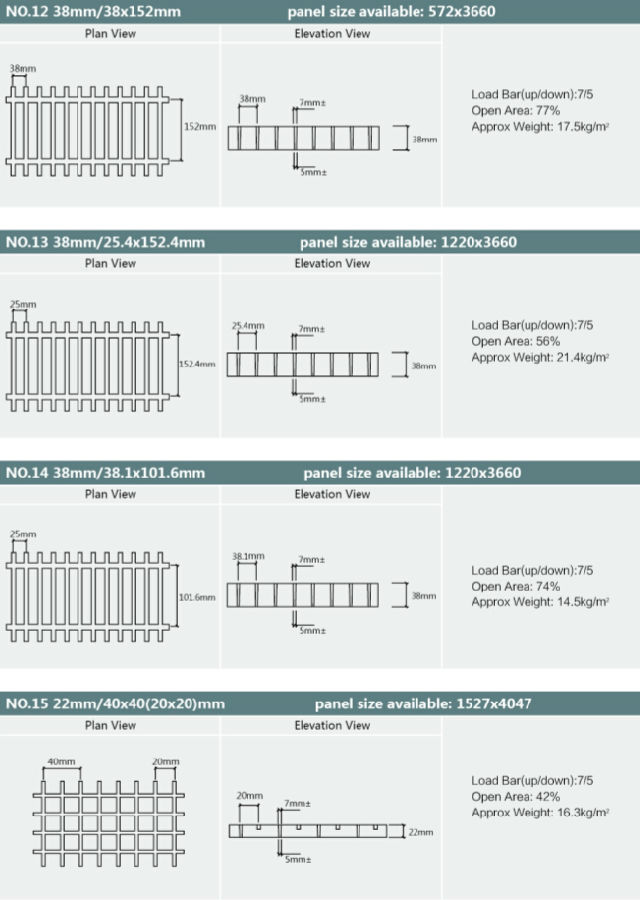
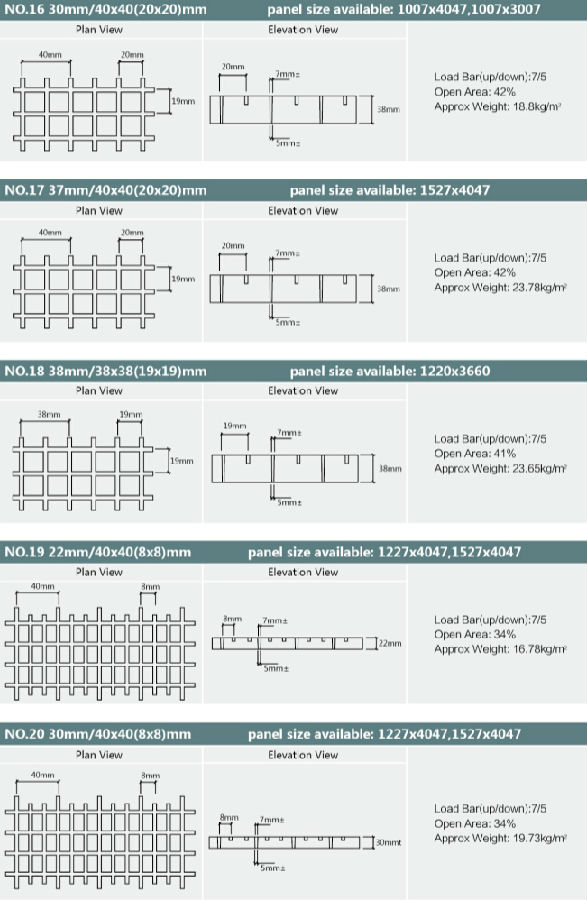
- Q: Can FRP pultrusion profiles be used in the aerospace industry?
- FRP pultrusion profiles are suitable for use in the aerospace industry. They possess several advantages that make them ideal for aerospace applications. Firstly, their high strength-to-weight ratios are crucial in the aerospace industry, where weight reduction is a top priority. This lightweight quality contributes to fuel efficiency and increased payload capacity. Secondly, FRP profiles have excellent corrosion resistance, making them perfect for aerospace applications that involve exposure to harsh environments like high altitude, extreme temperatures, and moisture. This resistance ensures the durability and longevity of the components, reducing maintenance and replacement costs. Additionally, FRP materials can be customized to meet specific design requirements, allowing engineers to easily create complex shapes and structures. This flexibility in design leads to enhanced performance and functionality in aerospace applications. Moreover, FRP pultrusion profiles exhibit exceptional fatigue resistance, enabling them to withstand the cyclic loading and stress cycles commonly encountered in aerospace operations. This characteristic ensures the reliability and safety of the components, which is paramount in the aerospace industry. Furthermore, FRP materials offer electrical insulation properties, which can be advantageous in aerospace applications where controlling or minimizing electrical conductivity is necessary. This insulation capability contributes to the overall safety and functionality of the components. In conclusion, FRP pultrusion profiles are a viable and attractive choice for various aerospace applications, including aircraft structures, interior components, radomes, and others. Their high strength-to-weight ratios, corrosion resistance, flexibility in design, fatigue resistance, and electrical insulation properties make them a suitable option for the aerospace industry.
- Q: Can FRP pultrusion profiles be used in the construction of water treatment plants?
- Water treatment plants can utilize FRP (Fiber Reinforced Polymer) pultrusion profiles. These profiles possess several advantages that render them suitable for this purpose. To begin with, FRP pultrusion profiles exhibit resistance to corrosion. Water treatment plants encounter various corrosive substances, such as chemicals and moisture. Traditional materials like steel and concrete can degrade over time due to corrosion, resulting in maintenance complications and potential structural failures. Nevertheless, FRP pultrusion profiles possess a high resistance to corrosion, ensuring prolonged durability and reduced maintenance expenses. Furthermore, FRP pultrusion profiles are lightweight and possess high strength-to-weight ratios. This characteristic facilitates easy handling and transportation while maintaining structural integrity. Water treatment plants often necessitate structural components that can endure heavy loads and support equipment. FRP pultrusion profiles supply the required strength without adding excessive weight, making them an ideal choice for such applications. Additionally, FRP pultrusion profiles are non-conductive and possess exceptional electrical insulation properties. This attribute proves critical in water treatment plants where electrical apparatus and wiring are present. The non-conductive nature of FRP aids in preventing electrical hazards and guarantees safe operation. Moreover, FRP pultrusion profiles can be customized to fulfill specific design requirements. They can be manufactured in various shapes and sizes, allowing for design and construction flexibility. This adaptability renders FRP pultrusion profiles appropriate for a wide array of applications within water treatment plants, including structural supports, walkways, handrails, and equipment enclosures. In conclusion, FRP pultrusion profiles represent an exceptional option for the construction of water treatment plants due to their corrosion resistance, lightweight yet robust nature, electrical insulation properties, and customization possibilities. They provide long-lasting durability, reduced maintenance costs, and enhanced safety, thereby constituting a reliable and efficient solution for this critical infrastructure.
- Q: Are FRP pultrusion profiles resistant to chemicals used in food packaging?
- Yes, FRP pultrusion profiles are generally resistant to the chemicals commonly used in food packaging. The combination of fiberglass reinforcement and resin matrix used in FRP profiles provides excellent chemical resistance, making them a suitable choice for applications involving contact with food packaging chemicals. However, it is always recommended to consult with the manufacturer or supplier to ensure specific compatibility with the chemicals involved.
- Q: Do FRP pultrusion profiles require any special tools for installation?
- Installation of FRP pultrusion profiles necessitates the use of specialized tools. These profiles are manufactured through a continuous process wherein fibers are drawn through a resin bath and subsequently into a heated die, resulting in a material that is not only strong and lightweight but also resistant to corrosion. To ensure the proper installation of FRP pultrusion profiles, various specific tools are commonly employed. These tools encompass: 1. Cutting Tools: During installation, it may be necessary to cut FRP profiles to specific lengths. To achieve clean and precise cuts, specialized cutting tools like high-speed saws or abrasive wheels are frequently utilized. 2. Drilling Tools: For the insertion of fasteners or other fittings, it might be necessary to drill holes in FRP profiles. To prevent damage to the profile while creating these holes, special drill bits designed for working with composite materials are typically employed. 3. Fastening Tools: Depending on the application, it may be necessary to fasten FRP profiles to other surfaces or structures. Commonly used fasteners include stainless steel screws, bolts, or adhesives, which are specifically chosen for their ability to securely hold the profiles in place. 4. Joining Tools: In certain instances, it may be necessary to join FRP profiles together in order to create longer lengths or more intricate shapes. To ensure a robust and secure connection, special joining techniques such as bonding, riveting, or the use of mechanical connectors are employed. It should be noted that the specific tools required for installation may vary depending on factors such as the complexity and size of the project, as well as the recommendations provided by the manufacturer. Therefore, it is always advisable to consult the manufacturer's installation guidelines or seek professional assistance to ensure the proper installation and optimal performance of FRP pultrusion profiles.
- Q: Are FRP pultrusion profiles resistant to fungi and mold?
- Yes, FRP (Fiber Reinforced Polymer) pultrusion profiles are generally resistant to fungi and mold. This is due to the non-porous nature of the materials used in their construction, such as fiberglass and epoxy resins. These materials do not provide a suitable environment for fungi and mold to grow, making FRP pultrusion profiles highly resistant to their growth and colonization. Furthermore, FRP pultrusion profiles are inherently moisture-resistant, which is another factor that discourages the growth of fungi and mold. Unlike traditional materials like wood, which can absorb moisture and provide a conducive environment for fungal and mold growth, FRP profiles do not absorb water and are therefore highly resistant to these issues. The combination of non-porous materials and moisture resistance makes FRP pultrusion profiles a suitable choice for applications where fungi and mold resistance is crucial, such as in humid or damp environments. However, it is important to note that no material is entirely immune to fungi and mold growth under all circumstances. In certain extreme conditions, where there is prolonged exposure to high levels of moisture and organic matter, it is still possible for some fungi and mold to colonize FRP profiles. However, compared to other materials, FRP pultrusion profiles offer a significantly higher level of resistance to these issues.
- Q: Are FRP pultrusion profiles resistant to humidity or moisture?
- Yes, FRP pultrusion profiles are highly resistant to humidity or moisture due to their non-porous nature and the use of corrosion-resistant materials.
- Q: Can FRP pultrusion profiles be used in chemical storage tanks?
- Indeed, it is possible to utilize FRP pultrusion profiles in the construction of chemical storage tanks. These profiles are recognized for their exceptional resistance to corrosion, rendering them suitable for the storage of a wide array of chemicals. Moreover, their lightweight nature, strength, and impressive strength-to-weight ratio make them an optimal choice for the creation of robust and long-lasting chemical storage tanks. Furthermore, FRP pultrusion profiles can be tailor-made to fulfill specific design requirements, enabling flexibility in tank design and construction. In summary, due to their corrosion resistance, strength, and customization capabilities, FRP pultrusion profiles emerge as a dependable and cost-efficient alternative for chemical storage tanks.
- Q: Can FRP pultrusion profiles be used for structural applications?
- Certainly, FRP pultrusion profiles can be utilized for structural purposes. The process of pultrusion involves pulling fiber reinforcements through a resin bath and a heated die to cure the resin, resulting in robust, lightweight, and corrosion-resistant profiles with exceptional mechanical properties. The high strength-to-weight ratio of FRP pultrusion profiles makes them widely employed in different structural applications. These profiles can be engineered to possess specific load-bearing capacities, stiffness, and durability, making them suitable for a wide range of structural requirements. FRP pultrusion profiles find common use in various structural applications such as bridges, walkways, platforms, handrails, supports, beams, columns, and reinforcements in concrete structures. They are particularly advantageous in situations where traditional materials like steel or wood are unsuitable due to concerns regarding corrosion, electrical conductivity, or weight. The benefits of FRP pultrusion profiles are numerous. They are lightweight, making them easy to handle and transport. Furthermore, they exhibit resistance to corrosion, chemicals, and UV radiation, ensuring long-term durability even in harsh environments. Additionally, they possess excellent dimensional stability, remaining unaffected by warping, twisting, or shrinking over time. To summarize, FRP pultrusion profiles are highly suitable for structural applications owing to their strength, lightweight nature, corrosion resistance, and durability. They provide a cost-effective alternative to traditional materials while delivering superior performance in various structural projects.
- Q: Are FRP pultrusion profiles suitable for the manufacturing of chemical reactors?
- Yes, FRP (Fiber Reinforced Polymer) pultrusion profiles are suitable for the manufacturing of chemical reactors. FRP pultrusion profiles offer several advantages that make them well-suited for this application. Firstly, FRP pultrusion profiles are highly corrosion-resistant, which is a critical characteristic for chemical reactors that are exposed to harsh chemicals. Unlike traditional materials like steel or concrete, FRP does not corrode or degrade when exposed to a wide range of chemicals, making it a reliable choice for chemical reactor construction. Secondly, FRP pultrusion profiles are lightweight yet strong, providing excellent structural integrity and durability. This allows for the construction of large-scale chemical reactors without adding excessive weight, reducing installation and transportation costs. Furthermore, FRP pultrusion profiles offer design flexibility, allowing for customization to meet specific requirements. They can be easily molded into various shapes and sizes, enabling the construction of complex reactor designs that optimize efficiency and performance. In addition, FRP pultrusion profiles have excellent thermal insulation properties, which can be advantageous in maintaining stable operating temperatures within chemical reactors. This can help improve the overall energy efficiency of the reactor and reduce heat loss. Overall, FRP pultrusion profiles are suitable for the manufacturing of chemical reactors due to their corrosion resistance, lightweight yet strong nature, design flexibility, and thermal insulation properties. These profiles offer a reliable and cost-effective solution for constructing chemical reactors that can withstand the demanding conditions of chemical processing.
- Q: Do FRP pultrusion profiles require any special tools for installation?
- Installation of FRP pultrusion profiles necessitates the use of specialized tools. These profiles are manufactured through a continuous process wherein fibers are drawn through a resin bath and subsequently into a heated die, resulting in a material that is not only strong and lightweight but also resistant to corrosion. To ensure the proper installation of FRP pultrusion profiles, various specific tools are commonly employed. These tools encompass: 1. Cutting Tools: During installation, it may be necessary to cut FRP profiles to specific lengths. To achieve clean and precise cuts, specialized cutting tools like high-speed saws or abrasive wheels are frequently utilized. 2. Drilling Tools: For the insertion of fasteners or other fittings, it might be necessary to drill holes in FRP profiles. To prevent damage to the profile while creating these holes, special drill bits designed for working with composite materials are typically employed. 3. Fastening Tools: Depending on the application, it may be necessary to fasten FRP profiles to other surfaces or structures. Commonly used fasteners include stainless steel screws, bolts, or adhesives, which are specifically chosen for their ability to securely hold the profiles in place. 4. Joining Tools: In certain instances, it may be necessary to join FRP profiles together in order to create longer lengths or more intricate shapes. To ensure a robust and secure connection, special joining techniques such as bonding, riveting, or the use of mechanical connectors are employed. It should be noted that the specific tools required for installation may vary depending on factors such as the complexity and size of the project, as well as the recommendations provided by the manufacturer. Therefore, it is always advisable to consult the manufacturer's installation guidelines or seek professional assistance to ensure the proper installation and optimal performance of FRP pultrusion profiles.
Send your message to us
FRP Pultrusion Profiles - Skid Resistance FRP Grating with Impact Resistance 2024
- Loading Port:
- Shanghai
- Payment Terms:
- TT OR LC
- Min Order Qty:
- 10 pc
- Supply Capability:
- 8000 pc/month
OKorder Service Pledge
OKorder Financial Service
Similar products
Hot products
Hot Searches
Related keywords
